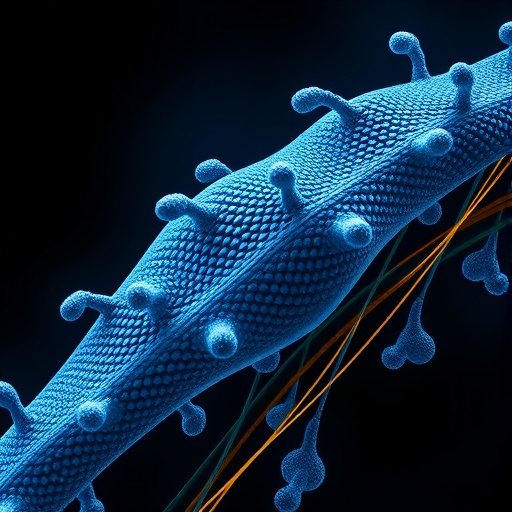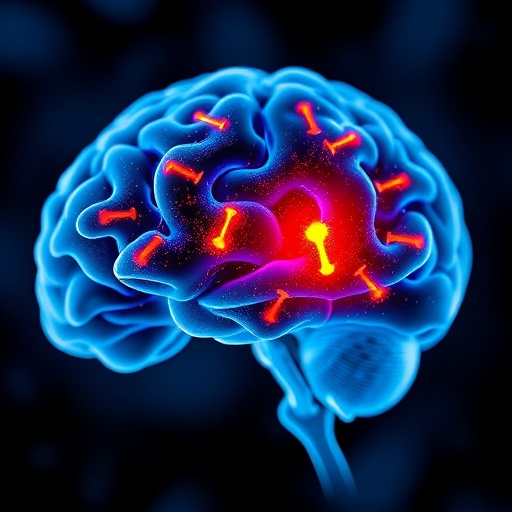In a groundbreaking study published in Nature Metabolism early this year, researchers have unveiled a detailed in vivo mapping of itaconate metabolism, illuminating its degradation pathways and kinetic turnover in living systems. Itaconate, a metabolite intricately linked to immune responses and metabolic reprogramming, has captivated scientists for its emerging roles in inflammation and host defense. However, until now, the comprehensive understanding of its fate and dynamics inside living organisms has remained elusive. This pioneering work by Willenbockel, Williams, Lucas, and colleagues bridges that critical knowledge gap, shedding light on the intricate biochemical journey of itaconate within the metabolic landscape of mammals.
The significance of this study lies in its robust in vivo tracing approach, enabling the first-ever real-time visualization and quantification of itaconate’s metabolic flux. Itaconate, a derivative of the TCA cycle intermediate cis-aconitate, accumulates prominently in activated macrophages, famously through the enzymatic activity of immune-responsive gene 1 (IRG1). This metabolite exerts antimicrobial effects and modulates inflammatory signaling; consequently, its metabolism and regulation have garnered intense scrutiny within immunometabolism fields. Previously, scientific understanding was limited to static snapshots or in vitro approximations, which failed to capture the dynamic complexity occurring in vivo. By employing sophisticated isotopic labeling combined with mass spectrometry, the authors succeeded in reconstructing the trajectory of itaconate turnover, providing unprecedented kinetic resolution.
The core methodology integrates stable isotope-resolved metabolomics (SIRM) with advanced liquid chromatography and tandem mass spectrometry analyses, allowing precise tracing of isotopically labeled itaconate molecules from their biosynthesis to ultimate degradation. The study meticulously tracks the incorporation of ^13C-labeled substrates fed into living animals, tracing the labeled carbons through endogenous itaconate pools and its downstream metabolites. This approach offers a temporal and quantitative lens into the birth, life, and decay of itaconate molecules within physiologically relevant contexts—an innovative departure from prior ex vivo or cell culture models. The data reveal distinct kinetic phases and highlight enzymatic nodes critical for metabolic fate decisions.
One of the standout revelations of this work is the identification of a novel itaconate degradation pathway mediated by the enzyme itaconyl-CoA hydratase (ICH). Previously, it was appreciated that itaconate exerted metabolic influence but less was known about its catabolism in vivo. The researchers demonstrate convincingly that itaconate is converted to itaconyl-CoA and subsequently hydrated, detailing an entire enzymatic cascade that enables its eventual breakdown and reintegration into central carbon metabolism. This discovery not only deepens understanding of itaconate’s biological role but also suggests new metabolic intersections that may regulate immune cell function and systemic metabolism under inflammatory conditions.
Beyond mapping the enzymatic route, the study elucidates the turnover kinetics of intracellular itaconate pools during immune activation. Using kinetic modeling of isotopologue data, the authors quantified turnover rates, revealing surprisingly rapid cycling of itaconate within macrophages responding to inflammatory stimuli. This rapid turnover implies that itaconate is dynamically regulated, supporting its role as a metabolic regulator that must be tightly controlled to balance antimicrobial activity with possible metabolic toxicity. These insights refine our view of itaconate from a static effector molecule to a actively managed metabolite whose life cycle is integral to cellular adaptation during stress.
The study also extends to in situ analyses of tissue-specific metabolism, highlighting that itaconate dynamics vary markedly between different organs under inflammatory challenges. For instance, macrophage-rich spleen tissues exhibit rapid itaconate turnover consistent with high IRG1 expression, whereas liver tissue demonstrates different metabolic flux patterns, reflecting distinct cell type compositions and metabolic states. Such spatial metabolic heterogeneity emphasizes the complexity of systemic itaconate biology and underscores the importance of in vivo investigations in whole organisms rather than isolated cell systems.
Crucially, the findings unlock therapeutic potential by delineating enzymatic checkpoints that might be pharmacologically targeted to modulate itaconate levels and activity. Given itaconate’s emerging role in mitigating excessive inflammation and its involvement in metabolic diseases and cancer, understanding its degradation pathways opens possibilities for intervention. Inhibiting enzymes responsible for itaconate catabolism could be an avenue to boost its immunoregulatory effects, whereas enhancing degradation might alleviate pathologies where itaconate accumulation is detrimental.
In addition to fundamental metabolic insights, this work contributes methodologically by demonstrating the power of integrated isotope tracing and high-resolution mass spectrometry in vivo. The combination enables capturing of subtle but biologically crucial metabolic fluxes with temporal precision unattainable by conventional metabolomics. This platform sets a new standard for studying small molecule metabolism and could be adapted to explore other immunometabolites or signaling molecules involved in health and disease. The authors’ approach provides a roadmap for dissecting the nuanced biochemical interplay underlying immune cell function.
Furthermore, the study’s revelations have profound implications for understanding inflammatory and infectious disease mechanisms. Itaconate’s antimicrobial activity includes inhibition of microbial isocitrate lyase, a key enzyme in pathogen metabolism. By detailing how host cells control itaconate availability and degradation, researchers gain insight into host-pathogen metabolic competition, potentially informing the development of new antimicrobial strategies that exploit metabolic vulnerabilities. The metabolic tug-of-war between host and pathogen centered on itaconate is now more clearly defined, illuminating an exciting frontier in infection biology.
At a broader scale, the work also informs research on metabolic reprogramming of immune cells—a hallmark of trained immunity and immunometabolic memory. Itaconate acts as a metabolic mediator capable of shaping epigenetic landscapes and transcriptional programs through its impact on reactive oxygen species and alkylation of thiol groups in proteins. By uncovering itaconate turnover and degradation kinetics, this paper allows scientists to better understand how transient metabolic signals sustain longer-term immune cell phenotypes, adding a dynamic dimension to concepts of metabolic memory.
The in vivo context of the experiments involved rigorous animal modeling, including inflammatory stimulations designed to mimic physiological immune challenges, strengthening the translational relevance of findings. Observing itaconate metabolism under realistic conditions rather than artificial stimuli or isolated cells provides a more accurate depiction of the molecule’s functional behavior. This integrative approach paves the way for future studies aiming to translate metabolic insights into clinical interventions aimed at modulating immunometabolism for therapeutic benefit.
In conclusion, Willenbockel and colleagues’ pioneering in vivo tracing of itaconate metabolism represents a watershed moment in immunometabolism research. By unveiling an uncharted degradation pathway and providing kinetic insights into itaconate’s dynamic regulation during inflammation, their work fundamentally advances our understanding of a metabolite critical to immune function. The study not only enhances basic biochemical knowledge but also opens promising avenues for therapeutic innovation against inflammatory diseases, metabolic disorders, and infections. As researchers continue to unravel the complex metabolic web in immunity, this transformative paper will serve as a foundational reference and inspiration for future discoveries.
The implications of this research spark exciting possibilities for drug development targeting the enzymes involved in itaconate turnover. As pharmaceutical interest grows in leveraging metabolic pathways to treat diseases, knowing the precise biochemical steps and kinetics of key metabolites like itaconate enables rational design of modulatory compounds. Such efforts could yield novel immunometabolic therapies tailored to enhance host defense or dampen pathological inflammation, impacting fields from autoimmunity to cancer immunotherapy.
Moreover, the study exemplifies the power of multidisciplinary collaboration, integrating biochemistry, analytical chemistry, immunology, and computational modeling to solve complex biological puzzles. The sophisticated isotope tracing and analytical methods required highlight the frontiers of current technology and experimental design necessary for accurate in vivo metabolic analysis. This sets a precedent and technical benchmark for future metabolic investigations in immunology and beyond.
Ultimately, this research enriches the growing narrative that metabolites are not mere byproducts but central players in immune regulation and cellular communication. Itaconate emerges more clearly as a versatile bioactive molecule whose life cycle within cells is finely orchestrated to meet the demands of host defense and metabolic balance. Unlocking these biochemical circuits deepens our grasp of how immune cells reprogram themselves at a molecular level, broadening horizons for understanding health, disease, and resilience.
Subject of Research: In vivo metabolic tracing of itaconate exploring its degradation pathways and turnover kinetics in mammalian immune cells.
Article Title: In vivo itaconate tracing reveals degradation pathway and turnover kinetics.
Article References:
Willenbockel, H.F., Williams, A.T., Lucas, A. et al. In vivo itaconate tracing reveals degradation pathway and turnover kinetics. Nat Metab (2025). https://doi.org/10.1038/s42255-025-01363-1
Image Credits: AI Generated
Tags: biochemical dynamics in living organismsdegradation kinetics of itaconateimmune responses and inflammationimmunometabolism research advancementsin vivo itaconate tracingisotopic labeling in researchitaconate metabolism pathwaysmacrophage activation and itaconatemass spectrometry in metabolic studiesmetabolic reprogramming in immunityNature Metabolism study on itaconatereal-time visualization of metabolism





